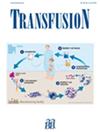实时绩效改进优化了损伤控制复苏最佳实践的坚持:前瞻性试点观察研究的结果
IF 2
3区 医学
Q2 HEMATOLOGY
引用次数: 0
摘要
背景在损伤控制复苏(DCR)过程中保持平衡的血液制品比例与生存率的提高有独立的关系。研究设计和方法从 2020 年 12 月到 2021 年 8 月,我们前瞻性地使用床旁 RT-PI 工具指导存活至少 30 分钟的重伤患者进行 DCR。将 RT-PI 研究患者与本机构的当代对照组患者和历史上的 PROMMTT 研究患者进行比较。同时还确定了在 6 小时内输血≥6 U 红细胞 (RBC) 的患者子集(MT+)。主要终点是6小时内血浆(PLAS):RBC和血小板(PLT):RBC处于高比率范围(≥3:4)的时间百分比。次要终点包括大量输血方案启动时间、钙和氨甲环酸(TXA)用药时间以及累计6小时比率。RT-PI(n = 10)患者在 6 小时的复苏过程中有 96% 的时间处于 PLAS:RBC 高值范围,与对照组(n = 87)(96%)相比没有差异,但高于 PROMMTT(n = 675)(25%,p < .001)。在 MT+ 亚组中,RT-PI(n = 4)与 PROMMTT(n = 391)患者的 PLAS 比值(p < .001)和 PLT 比值(p < .001)在整个 6 小时内均保持最佳 PLAS:RBC 和 PLT:RBC 比值。在这项前瞻性研究中,RT-PI 与优化的 DCR 相关。这项前瞻性研究表明,RT-PI 与 DCR 的优化有关。需要对这种优化 DCR 实施的新方法进行多中心验证。本文章由计算机程序翻译,如有差异,请以英文原文为准。
Real‐time performance improvement optimizes damage control resuscitation best practice adherence: Results of a pilot prospective observational study
BackgroundMaintaining balanced blood product ratios during damage control resuscitation (DCR) is independently associated with improved survival. We hypothesized that real‐time performance improvement (RT‐PI) would increase adherence to DCR best practice.Study Design and MethodsFrom December 2020–August 2021, we prospectively used a bedside RT‐PI tool to guide DCR in severely injured patients surviving at least 30 min. RT‐PI study patients were compared to contemporary control patients at our institution and historic PROMMTT study patients. A subset of patients transfused ≥6 U red blood cells (RBC) in 6 h (MT+) was also identified. The primary endpoint was percentage time in a high ratio range (≥3:4) of plasma (PLAS):RBC and platelet (PLT):RBC over 6 h. Secondary endpoints included time to massive transfusion protocol activation, time to calcium and tranexamic acid (TXA) dosing, and cumulative 6‐h ratios.ResultsIncluded patients (n = 772) were 35 (24–51) years old with an Injury Severity Score of 27 (17–38) and 42% had penetrating injuries. RT‐PI (n = 10) patients spent 96% of the 6‐h resuscitation in a high PLAS:RBC range, no different versus CONTROL (n = 87) (96%) but more than PROMMTT (n = 675) (25%, p < .001). In the MT+ subgroup, optimal PLAS:RBC and PLT:RBC were maintained for the entire 6 h in RT‐PI (n = 4) versus PROMMTT (n = 391) patients for both PLAS (p < .001) and PLT ratios (p < .001). Time to TXA also improved significantly in RT‐PI versus CONTROL patients (27 min [22–31] vs. 51 min [29–98], p = .035).ConclusionIn this prospective study, RT‐PI was associated with optimized DCR. Multicenter validation of this novel approach to optimizing DCR implementation is warranted.
求助全文
通过发布文献求助,成功后即可免费获取论文全文。
去求助
来源期刊

Transfusion
医学-血液学
CiteScore
4.70
自引率
20.70%
发文量
426
审稿时长
1 months
期刊介绍:
TRANSFUSION is the foremost publication in the world for new information regarding transfusion medicine. Written by and for members of AABB and other health-care workers, TRANSFUSION reports on the latest technical advances, discusses opposing viewpoints regarding controversial issues, and presents key conference proceedings. In addition to blood banking and transfusion medicine topics, TRANSFUSION presents submissions concerning patient blood management, tissue transplantation and hematopoietic, cellular, and gene therapies.
 求助内容:
求助内容: 应助结果提醒方式:
应助结果提醒方式:


